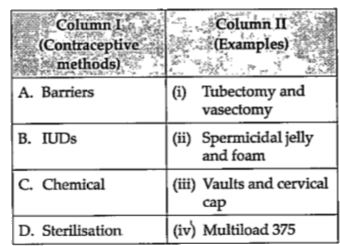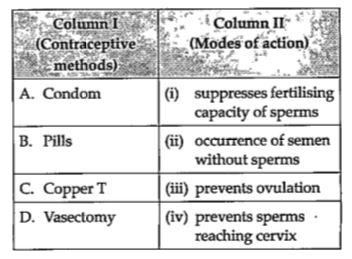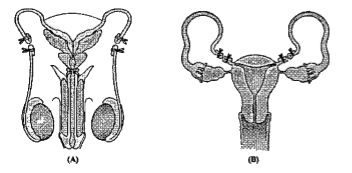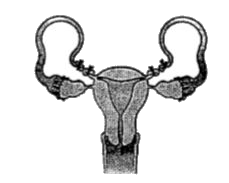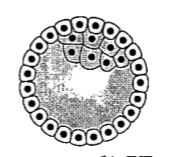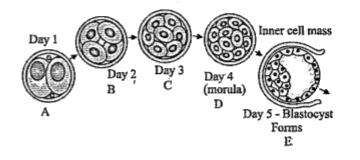CHOOSE THE ODD ONE OUT OF THE FOLLOWING from SRIJAN BIOLOGY (ENGLISH) REPRODUCTIVE HEALTH for Class 12
| Class 12 | BIOLOGY |
| Chapter | REPRODUCTIVE HEALTH |
| SRIJAN BIOLOGY (ENGLISH) | CHOOSE THE ODD ONE OUT OF THE FOLLOWING |
| Medium | English |
| Academic Year | 2023-2024 |
Question 2
Diaphragms are contraceptive device used by females. Choose the correct option from the statement given below:
(i) They are introduced into the uterus.
(ii) They are placed to cover the cervical region
(iii) They act as physical barrier for sperm entry
(iv) They act as spermicidal agents View SolutionQuestion 28
Sterilisation techniques are generally fool proof methods of contraception with least side effects. Yet, this is the last option for the couples because:
(i) It is almost irreversible
(ii) Of the misconception that it will reduce sexual urge.
(iii) It is a surgical procedure
(iv) Of lack of sufficient facilities in many parts of the country
Choose the correct option: View SolutionQuestion 43
Fill in the blanks in the following paragraph by selecting the correct option.................A....... .... methods work on the principle of avoiding chances of ovum and sperms meeting................. is one such method in which the couples avoid coitus from day 10 17 of the menstrual cycle. .. .... ............ is another method in which the male partner withdraws his penis from the vagina just before ejaculation so as to avoid insemination........... D................. method is based on the fact that ovulation and therefore, the cycle do not occur during the period of intense lactation following parturition.View SolutionQuestion 49
Inability of an individual to inseminate the female or due to very low sperm counts in ejaculates leads to ............. A .... ..... It could be corrected by ............... B................. In this technique, the ................. ............ is collected and artificially introduced either into the vagina or into the ............... D ............. of the female. View SolutionQuestion 72
Assertion: MTP is carried out to get rid of unwanted pregnancies either due to casual unprotected intercourse or failure of the contraceptive used during coitus or rapes.
Reason: MTP is also essential in certain cases where continuation of the pregnancy could be harmful or even fatal either to the mother or to the foetus or both.View SolutionQuestion 74
Assisted Reproductive Technology (ART) is a medical intervention developed to improve an 'infertile' couple's chance of pregnancy. 'Infertility' is clinically accepted as the inability to conceive after 12 months of actively trying to conceive. The means of ART involves separating procreation from sexual intercourse - the importance of this association is addressed in bioethics.
Assisted reproductive technology and its use directly impact the foundational unit of society - the family. ART enables children to be conceived who have no genetic relationship to one or both of their parents. Children can also be conceived who will never have a social relationship with one or both of their genetic parents, e.g. a child conceived using donor sperm. Non-infertile people in today's society including both male and female homosexual couples, single men and women, and post-menopausal women are seeking the assistance of ART.
Assisted Reproductive Technology does not include: View SolutionQuestion 75
Assisted Reproductive Technology (ART) is a medical intervention developed to improve an 'infertile' couple's chance of pregnancy. 'Infertility' is clinically accepted as the inability to conceive after 12 months of actively trying to conceive. The means of ART involves separating procreation from sexual intercourse - the importance of this association is addressed in bioethics.
Assisted reproductive technology and its use directly impact the foundational unit of society - the family. ART enables children to be conceived who have no genetic relationship to one or both of their parents. Children can also be conceived who will never have a social relationship with one or both of their genetic parents, e.g. a child conceived using donor sperm. Non-infertile people in today's society including both male and female homosexual couples, single men and women, and post-menopausal women are seeking the assistance of ART.
The method of directly injecting a sperm into ovum in assisted reproductive technology is called: View SolutionQuestion 76
Assisted Reproductive Technology (ART) is a medical intervention developed to improve an 'infertile' couple's chance of pregnancy. 'Infertility' is clinically accepted as the inability to conceive after 12 months of actively trying to conceive. The means of ART involves separating procreation from sexual intercourse - the importance of this association is addressed in bioethics.
Assisted reproductive technology and its use directly impact the foundational unit of society - the family. ART enables children to be conceived who have no genetic relationship to one or both of their parents. Children can also be conceived who will never have a social relationship with one or both of their genetic parents, e.g. a child conceived using donor sperm. Non-infertile people in today's society including both male and female homosexual couples, single men and women, and post-menopausal women are seeking the assistance of ART.
Artificial reproductive techniques are not always applicable because: View SolutionQuestion 77
Assisted Reproductive Technology (ART) is a medical intervention developed to improve an 'infertile' couple's chance of pregnancy. 'Infertility' is clinically accepted as the inability to conceive after 12 months of actively trying to conceive. The means of ART involves separating procreation from sexual intercourse - the importance of this association is addressed in bioethics.
Assisted reproductive technology and its use directly impact the foundational unit of society - the family. ART enables children to be conceived who have no genetic relationship to one or both of their parents. Children can also be conceived who will never have a social relationship with one or both of their genetic parents, e.g. a child conceived using donor sperm. Non-infertile people in today's society including both male and female homosexual couples, single men and women, and post-menopausal women are seeking the assistance of ART.
A childless couple can be assisted to have a child through a technique called GIFT. The full form of this technique is:View SolutionQuestion 78
When couples, are unable to achieve coital pregnancy, they often turn to assisted reproductive technologies. A popular assisted reproductive technology is In Vitro Fertilisation (IVF). In the simplest case, a woman is given a course of hormone treatments to cause her ovaries to produce multiple eggs. The eggs are surgically removed just prior to ovulation. They are then placed in a culture dish with the father's sperm.
During the next few days, the dish is periodically examined to see if fertilization has occurred. In approximately 48 hours, when the embryos reach the eight-cell stage, those that appear healthy and that are growing normally are transferred where, it is hoped, some will implant and develop full term. A woman may have to undergo several treatment cycles before she becomes pregnant.
ZIFT is transfer of:View SolutionQuestion 79
When couples, are unable to achieve coital pregnancy, they often turn to assisted reproductive technologies. A popular assisted reproductive technology is In Vitro Fertilisation (IVF). In the simplest case, a woman is given a course of hormone treatments to cause her ovaries to produce multiple eggs. The eggs are surgically removed just prior to ovulation. They are then placed in a culture dish with the father's sperm.
During the next few days, the dish is periodically examined to see if fertilization has occurred. In approximately 48 hours, when the embryos reach the eight-cell stage, those that appear healthy and that are growing normally are transferred where, it is hoped, some will implant and develop full term. A woman may have to undergo several treatment cycles before she becomes pregnant.
Embryo with more than 16 blastomeres formed due to In Vitro Fertilisation is transferred into: View SolutionQuestion 80
When couples, are unable to achieve coital pregnancy, they often turn to assisted reproductive technologies. A popular assisted reproductive technology is In Vitro Fertilisation (IVF). In the simplest case, a woman is given a course of hormone treatments to cause her ovaries to produce multiple eggs. The eggs are surgically removed just prior to ovulation. They are then placed in a culture dish with the father's sperm.
During the next few days, the dish is periodically examined to see if fertilization has occurred. In approximately 48 hours, when the embryos reach the eight-cell stage, those that appear healthy and that are growing normally are transferred where, it is hoped, some will implant and develop full term. A woman may have to undergo several treatment cycles before she becomes pregnant.
In case of a couple, where the male is having a very low sperm count, which technique will be suitable for fertilization? View SolutionQuestion 81
When couples, are unable to achieve coital pregnancy, they often turn to assisted reproductive technologies. A popular assisted reproductive technology is In Vitro Fertilisation (IVF). In the simplest case, a woman is given a course of hormone treatments to cause her ovaries to produce multiple eggs. The eggs are surgically removed just prior to ovulation. They are then placed in a culture dish with the father's sperm.
During the next few days, the dish is periodically examined to see if fertilization has occurred. In approximately 48 hours, when the embryos reach the eight-cell stage, those that appear healthy and that are growing normally are transferred where, it is hoped, some will implant and develop full term. A woman may have to undergo several treatment cycles before she becomes pregnant.
Artificial insemination means:View SolutionQuestion 82
India was amongst the first countries in the world to initiate action plans and programmes at a national level to attain total reproductive health as a social goal. These programmes called 'family planning were initiated in 1951 and were periodically assessed over the past decades. Improved programmes covering wider reproduction-related areas are currently in operation under the popular name 'Reproductive and Child Health Care (RCH) programmes'. Creating awareness among people about various reproduction related aspects and providing facilities and support for building up a reproductively healthy society are the major tasks under these programmes. With the help of audiovisual and the print-media governmental and non-governmental agencies have taken various steps to create awareness among the people about reproduction-related aspects. Introduction of sex education in schools should also be encouraged to provide right information to the young so as to discourage children from believing in myths and having misconceptions about sex related aspects. Proper information about reproductive organs, adolescence and related changes, safe and hygienic sexual practices, sexually transmitted diseases (STD), AIDS, etc., would help people, especially those in the adolescent age group to lead a reproductively healthy life.
Which among the following is the 1st country in the world to initiate action plan to attain total reproductive health ? View SolutionQuestion 83
India was amongst the first countries in the world to initiate action plans and programmes at a national level to attain total reproductive health as a social goal. These programmes called 'family planning were initiated in 1951 and were periodically assessed over the past decades. Improved programmes covering wider reproduction-related areas are currently in operation under the popular name 'Reproductive and Child Health Care (RCH) programmes'. Creating awareness among people about various reproduction related aspects and providing facilities and support for building up a reproductively healthy society are the major tasks under these programmes. With the help of audiovisual and the print-media governmental and non-governmental agencies have taken various steps to create awareness among the people about reproduction-related aspects. Introduction of sex education in schools should also be encouraged to provide right information to the young so as to discourage children from believing in myths and having misconceptions about sex related aspects. Proper information about reproductive organs, adolescence and related changes, safe and hygienic sexual practices, sexually transmitted diseases (STD), AIDS, etc., would help people, especially those in the adolescent age group to lead a reproductively healthy life.
In which year was 'Family Planning progamme launched?View SolutionQuestion 84
India was amongst the first countries in the world to initiate action plans and programmes at a national level to attain total reproductive health as a social goal. These programmes called 'family planning were initiated in 1951 and were periodically assessed over the past decades. Improved programmes covering wider reproduction-related areas are currently in operation under the popular name 'Reproductive and Child Health Care (RCH) programmes'. Creating awareness among people about various reproduction related aspects and providing facilities and support for building up a reproductively healthy society are the major tasks under these programmes. With the help of audiovisual and the print-media governmental and non-governmental agencies have taken various steps to create awareness among the people about reproduction-related aspects. Introduction of sex education in schools should also be encouraged to provide right information to the young so as to discourage children from believing in myths and having misconceptions about sex related aspects. Proper information about reproductive organs, adolescence and related changes, safe and hygienic sexual practices, sexually transmitted diseases (STD), AIDS, etc., would help people, especially those in the adolescent age group to lead a reproductively healthy life.
Under reproductive health programme, what is the full form of RCH? View SolutionQuestion 85
India was amongst the first countries in the world to initiate action plans and programmes at a national level to attain total reproductive health as a social goal. These programmes called 'family planning were initiated in 1951 and were periodically assessed over the past decades. Improved programmes covering wider reproduction-related areas are currently in operation under the popular name 'Reproductive and Child Health Care (RCH) programmes'. Creating awareness among people about various reproduction related aspects and providing facilities and support for building up a reproductively healthy society are the major tasks under these programmes. With the help of audiovisual and the print-media governmental and non-governmental agencies have taken various steps to create awareness among the people about reproduction-related aspects. Introduction of sex education in schools should also be encouraged to provide right information to the young so as to discourage children from believing in myths and having misconceptions about sex related aspects. Proper information about reproductive organs, adolescence and related changes, safe and hygienic sexual practices, sexually transmitted diseases (STD), AIDS, etc., would help people, especially those in the adolescent age group to lead a reproductively healthy life.
What is full form of STDs ?View SolutionQuestion 86
India was amongst the first countries in the world to initiate action plans and programmes at a national level to attain total reproductive health as a social goal. These programmes called 'family planning were initiated in 1951 and were periodically assessed over the past decades. Improved programmes covering wider reproduction-related areas are currently in operation under the popular name 'Reproductive and Child Health Care (RCH) programmes'. Creating awareness among people about various reproduction related aspects and providing facilities and support for building up a reproductively healthy society are the major tasks under these programmes. With the help of audiovisual and the print-media governmental and non-governmental agencies have taken various steps to create awareness among the people about reproduction-related aspects. Introduction of sex education in schools should also be encouraged to provide right information to the young so as to discourage children from believing in myths and having misconceptions about sex related aspects. Proper information about reproductive organs, adolescence and related changes, safe and hygienic sexual practices, sexually transmitted diseases (STD), AIDS, etc., would help people, especially those in the adolescent age group to lead a reproductively healthy life.
Which of the following causes AIDS ?View SolutionQuestion 87
Intentional or voluntary termination of pregnancy before full term is called medical termination of pregnancy (MTP) or induced abortion. Nearly 45 to 50 million MTPs are performed in a year all over the world which accounts to 1/5th of the total number of conceived pregnancies in a year. Whether to accept legalise MTP or not is being debated upon in many countries due to emotional, ethical, religious and social issues involved in it. Government of India legalised MTP in 1971 with some strict conditions to avoid its misuse.
Such restrictions are all the more important to check indiscriminate and illegal female foeticides which are reported to be high in India. Why MTP? Obviously the answer is to get rid of unwanted pregnancies either due to casual unprotected intercourse or failure of the contraceptive used during coitus or rapes. MTPs are also essential in certain cases where continuation of the pregnancy could be harmful or even fatal either to the mother or to the foetus or both. MTPs are considered relatively safe during the first trimester, i.e., upto 12 weeks of pregnancy. Second trimester abortions are much more riskier. One disturbing trend observed is that a majority of the MTPs are performed illegally by unqualified quacks which are not only unsafe but could be fatal too. Another dangerous trend is the misuse of amniocentesis to determine the sex of the unborn child. Frequently, if the foetus is found to be female, it is followed by MTP- this is totally against what is legal.
What is the full form of MTP ?View SolutionQuestion 88
Intentional or voluntary termination of pregnancy before full term is called medical termination of pregnancy (MTP) or induced abortion. Nearly 45 to 50 million MTPs are performed in a year all over the world which accounts to 1/5th of the total number of conceived pregnancies in a year. Whether to accept legalise MTP or not is being debated upon in many countries due to emotional, ethical, religious and social issues involved in it. Government of India legalised MTP in 1971 with some strict conditions to avoid its misuse.
Such restrictions are all the more important to check indiscriminate and illegal female foeticides which are reported to be high in India. Why MTP? Obviously the answer is to get rid of unwanted pregnancies either due to casual unprotected intercourse or failure of the contraceptive used during coitus or rapes. MTPs are also essential in certain cases where continuation of the pregnancy could be harmful or even fatal either to the mother or to the foetus or both. MTPs are considered relatively safe during the first trimester, i.e., upto 12 weeks of pregnancy. Second trimester abortions are much more riskier. One disturbing trend observed is that a majority of the MTPs are performed illegally by unqualified quacks which are not only unsafe but could be fatal too. Another dangerous trend is the misuse of amniocentesis to determine the sex of the unborn child. Frequently, if the foetus is found to be female, it is followed by MTP- this is totally against what is legal.
Which of the following is the alternative / other name of MTP ? View SolutionQuestion 89
Intentional or voluntary termination of pregnancy before full term is called medical termination of pregnancy (MTP) or induced abortion. Nearly 45 to 50 million MTPs are performed in a year all over the world which accounts to 1/5th of the total number of conceived pregnancies in a year. Whether to accept legalise MTP or not is being debated upon in many countries due to emotional, ethical, religious and social issues involved in it. Government of India legalised MTP in 1971 with some strict conditions to avoid its misuse.
Such restrictions are all the more important to check indiscriminate and illegal female foeticides which are reported to be high in India. Why MTP? Obviously the answer is to get rid of unwanted pregnancies either due to casual unprotected intercourse or failure of the contraceptive used during coitus or rapes. MTPs are also essential in certain cases where continuation of the pregnancy could be harmful or even fatal either to the mother or to the foetus or both. MTPs are considered relatively safe during the first trimester, i.e., upto 12 weeks of pregnancy. Second trimester abortions are much more riskier. One disturbing trend observed is that a majority of the MTPs are performed illegally by unqualified quacks which are not only unsafe but could be fatal too. Another dangerous trend is the misuse of amniocentesis to determine the sex of the unborn child. Frequently, if the foetus is found to be female, it is followed by MTP- this is totally against what is legal.
Which of the following is not a reason for the debate of legalizing MTP in many countries? View SolutionQuestion 90
Intentional or voluntary termination of pregnancy before full term is called medical termination of pregnancy (MTP) or induced abortion. Nearly 45 to 50 million MTPs are performed in a year all over the world which accounts to 1/5th of the total number of conceived pregnancies in a year. Whether to accept legalise MTP or not is being debated upon in many countries due to emotional, ethical, religious and social issues involved in it. Government of India legalised MTP in 1971 with some strict conditions to avoid its misuse.
Such restrictions are all the more important to check indiscriminate and illegal female foeticides which are reported to be high in India. Why MTP? Obviously the answer is to get rid of unwanted pregnancies either due to casual unprotected intercourse or failure of the contraceptive used during coitus or rapes. MTPs are also essential in certain cases where continuation of the pregnancy could be harmful or even fatal either to the mother or to the foetus or both. MTPs are considered relatively safe during the first trimester, i.e., upto 12 weeks of pregnancy. Second trimester abortions are much more riskier. One disturbing trend observed is that a majority of the MTPs are performed illegally by unqualified quacks which are not only unsafe but could be fatal too. Another dangerous trend is the misuse of amniocentesis to determine the sex of the unborn child. Frequently, if the foetus is found to be female, it is followed by MTP- this is totally against what is legal.
What restriction has been posed by Government of India on the use of MTP? View SolutionQuestion 91
Intentional or voluntary termination of pregnancy before full term is called medical termination of pregnancy (MTP) or induced abortion. Nearly 45 to 50 million MTPs are performed in a year all over the world which accounts to 1/5th of the total number of conceived pregnancies in a year. Whether to accept legalise MTP or not is being debated upon in many countries due to emotional, ethical, religious and social issues involved in it. Government of India legalised MTP in 1971 with some strict conditions to avoid its misuse.
Such restrictions are all the more important to check indiscriminate and illegal female foeticides which are reported to be high in India. Why MTP? Obviously the answer is to get rid of unwanted pregnancies either due to casual unprotected intercourse or failure of the contraceptive used during coitus or rapes. MTPs are also essential in certain cases where continuation of the pregnancy could be harmful or even fatal either to the mother or to the foetus or both. MTPs are considered relatively safe during the first trimester, i.e., upto 12 weeks of pregnancy. Second trimester abortions are much more riskier. One disturbing trend observed is that a majority of the MTPs are performed illegally by unqualified quacks which are not only unsafe but could be fatal too. Another dangerous trend is the misuse of amniocentesis to determine the sex of the unborn child. Frequently, if the foetus is found to be female, it is followed by MTP- this is totally against what is legal.
Which of the following is not the correct reason for the use of MTP? View SolutionQuestion 92
Infections or diseases which are transmitted through sexual intercourse are collectively called sexually transmitted infections (STI) or venereal diseases (VD) or reproductive tract infections (RTI). Gonorrhoea, syphilis, genital herpes, chlamydiasis, genital warts, trichomoniasis, hepatitis B and of course, the most discussed infection in the recent years, HIV leading to AIDS are some of the common STIs. Among these, HIV infection is most dangerous. Some of these infections like hepatitis-B and HIV can also be transmitted by sharing of injection needles, surgical instruments, etc., with infected persons, transfusion of blood, or from an infected mother to the foetus too. Except for hepatitis-B, genital herpes and HIV infections, other diseases are completely curable if detected early and treated properly. Infected females may often be asymptomatic and hence, may remain undetected for long. Absence or less significant symptoms in the early stages of infection and the social stigma attached to the STIs, deter the infected persons from going for timely detection and proper treatment. This could lead to complications later, which include pelvic inflammatory diseases (PID), abortions, still births, ectopic pregnancies, infertility or even cancer of the reproductive tract. Though all persons are vulnerable to these infections, their incidences are reported to be very high among persons in the age group of 15-24 years - the age group to which you also belong. There is no reason to panic because prevention is possible.
STIs are most common in which age group?View SolutionQuestion 93
Infections or diseases which are transmitted through sexual intercourse are collectively called sexually transmitted infections (STI) or venereal diseases (VD) or reproductive tract infections (RTI). Gonorrhoea, syphilis, genital herpes, chlamydiasis, genital warts, trichomoniasis, hepatitis B and of course, the most discussed infection in the recent years, HIV leading to AIDS are some of the common STIs. Among these, HIV infection is most dangerous. Some of these infections like hepatitis-B and HIV can also be transmitted by sharing of injection needles, surgical instruments, etc., with infected persons, transfusion of blood, or from an infected mother to the foetus too. Except for hepatitis-B, genital herpes and HIV infections, other diseases are completely curable if detected early and treated properly. Infected females may often be asymptomatic and hence, may remain undetected for long. Absence or less significant symptoms in the early stages of infection and the social stigma attached to the STIs, deter the infected persons from going for timely detection and proper treatment. This could lead to complications later, which include pelvic inflammatory diseases (PID), abortions, still births, ectopic pregnancies, infertility or even cancer of the reproductive tract. Though all persons are vulnerable to these infections, their incidences are reported to be very high among persons in the age group of 15-24 years - the age group to which you also belong. There is no reason to panic because prevention is possible.
The overall number of cases of STIs is:View SolutionQuestion 94
Infections or diseases which are transmitted through sexual intercourse are collectively called sexually transmitted infections (STI) or venereal diseases (VD) or reproductive tract infections (RTI). Gonorrhoea, syphilis, genital herpes, chlamydiasis, genital warts, trichomoniasis, hepatitis B and of course, the most discussed infection in the recent years, HIV leading to AIDS are some of the common STIs. Among these, HIV infection is most dangerous. Some of these infections like hepatitis-B and HIV can also be transmitted by sharing of injection needles, surgical instruments, etc., with infected persons, transfusion of blood, or from an infected mother to the foetus too. Except for hepatitis-B, genital herpes and HIV infections, other diseases are completely curable if detected early and treated properly. Infected females may often be asymptomatic and hence, may remain undetected for long. Absence or less significant symptoms in the early stages of infection and the social stigma attached to the STIs, deter the infected persons from going for timely detection and proper treatment. This could lead to complications later, which include pelvic inflammatory diseases (PID), abortions, still births, ectopic pregnancies, infertility or even cancer of the reproductive tract. Though all persons are vulnerable to these infections, their incidences are reported to be very high among persons in the age group of 15-24 years - the age group to which you also belong. There is no reason to panic because prevention is possible.
As long as a person has no symptoms of an STI, theyView SolutionQuestion 95
Infections or diseases which are transmitted through sexual intercourse are collectively called sexually transmitted infections (STI) or venereal diseases (VD) or reproductive tract infections (RTI). Gonorrhoea, syphilis, genital herpes, chlamydiasis, genital warts, trichomoniasis, hepatitis B and of course, the most discussed infection in the recent years, HIV leading to AIDS are some of the common STIs. Among these, HIV infection is most dangerous. Some of these infections like hepatitis-B and HIV can also be transmitted by sharing of injection needles, surgical instruments, etc., with infected persons, transfusion of blood, or from an infected mother to the foetus too. Except for hepatitis-B, genital herpes and HIV infections, other diseases are completely curable if detected early and treated properly. Infected females may often be asymptomatic and hence, may remain undetected for long. Absence or less significant symptoms in the early stages of infection and the social stigma attached to the STIs, deter the infected persons from going for timely detection and proper treatment. This could lead to complications later, which include pelvic inflammatory diseases (PID), abortions, still births, ectopic pregnancies, infertility or even cancer of the reproductive tract. Though all persons are vulnerable to these infections, their incidences are reported to be very high among persons in the age group of 15-24 years - the age group to which you also belong. There is no reason to panic because prevention is possible.
Which of these is a health problem that can be caused by STIs in women?View SolutionQuestion 96
Infections or diseases which are transmitted through sexual intercourse are collectively called sexually transmitted infections (STI) or venereal diseases (VD) or reproductive tract infections (RTI). Gonorrhoea, syphilis, genital herpes, chlamydiasis, genital warts, trichomoniasis, hepatitis B and of course, the most discussed infection in the recent years, HIV leading to AIDS are some of the common STIs. Among these, HIV infection is most dangerous. Some of these infections like hepatitis-B and HIV can also be transmitted by sharing of injection needles, surgical instruments, etc., with infected persons, transfusion of blood, or from an infected mother to the foetus too. Except for hepatitis-B, genital herpes and HIV infections, other diseases are completely curable if detected early and treated properly. Infected females may often be asymptomatic and hence, may remain undetected for long. Absence or less significant symptoms in the early stages of infection and the social stigma attached to the STIs, deter the infected persons from going for timely detection and proper treatment. This could lead to complications later, which include pelvic inflammatory diseases (PID), abortions, still births, ectopic pregnancies, infertility or even cancer of the reproductive tract. Though all persons are vulnerable to these infections, their incidences are reported to be very high among persons in the age group of 15-24 years - the age group to which you also belong. There is no reason to panic because prevention is possible.
Which is the most common STI caused by bacteria?View Solution
All Exercises from SRIJAN BIOLOGY (ENGLISH) Class 12 BIOLOGY REPRODUCTIVE HEALTH
- ASSERTION AND REASON
- CHOOSE THE ODD ONE OUT OF THE FOLLOWING
- FIGURE BASED QUESTIONS
- FILL IN THE BLANKS
- IILUSTRATIVE QUESTIONS
- MATCH THE FOLLOWING
- MULTIPLE CHOICE QUESTIONS
- SOURCE BASED QUESTIONS
- PRACTICE QUESTION ( LONG ANSWER TYPE QUESTION )
- PRACTICE QUESTION ( SHORT ANSWER TYPE-I)
- PRACTICE QUESTION ( SHORT ANSWER TYPE-II)
- PRACTICE QUESTION( VERY SHORT ANSWER TYPE QUESTIONS)
- PREVIOUS YEARS BOARD PAPER QUESTIONS ( SHORT ANSWER TYPE -I )
- PREVIOUS YEARS BOARD PAPER QUESTIONS ( SHORT ANSWER TYPE -II )
- PREVIOUS YEARS BOARD PAPER QUESTIONS ( VERY SHOT ANSWER TYPE QUESTION )
- REVIEW QUESTIONS
- OBJECTIVE TYPE QUESTIONS ( ASSERTION AND REASON TYPE QUESTION)
- OBJECTIVE TYPE QUESTIONS ( MULTIPLE CHOICE QUESTION (MCQ) )
